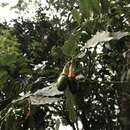ar
الأسماء في صفحات التنقل


It is found in forest gaps, meaning that it is a pioneer species (Gibson and Wheelwright, 1995). O. tenera utilizes the increased sunlight availability that has resulted from some kind of disturbance to grow as rapidly as possible before it is shaded by the other canopy species. Characteristic of understory species, Ocotea tenera also has the ability to persist as a sapling in heavy shade for multiple years (Wheelwright and Bruneau, 1992).
Ocotea tenera is a neotropical understory tree that is endemic to the Costa Rican lower montane, moist forest areas (Wheelwright et al., 2012). It is part of the Lauraceae family and is most commonly found in elevations that range from 1000 to 1400 meters (Wheelwright et al., 2012). O. tenera is effectively diecious, but has sometimes been observed as a gynodioecious tree species, that has simple, elliptic leaves and flowers during the early to mid-rainy season (Wheelwright and Logan, 2004). Gynodioecious is a type of dimorphic breeding system where females coexist with hermaphroditic individuals in populations, whereas diecious simply means the male and female organs are in separate and distinct individuals. The flowering of O. tenera occurs in inflorescences that differ slightly from female to the male or sometimes hermaphroditic trees; the larger and shorter lived, white flowers are produced by the hermaphrodites. Flowers belonging to the female trees are still white but are smaller and live longer. The white flowers attract small insects as their pollinators (Wheelwright et al., 2012). These flowers then turn into infructescences that ripen during the months February and March, marking the mid dry season (Nadkarni and Wheelwright, 2000). The bulky single seeded fruits start green and ripen to a dark blue/black color and are dispersed by large frugivorous birds (Wheelwright and Logan, 2004).
Ocotea tenera is endemic to the lower montane moist forest areas of the Atlantic slope of Costa Rica and ranges from 900 to 1400 meters (Wheelwright and Bruneau 1992,Wheelwright et al, 2012). It is endemic to Costa Rica and populates the Atlantic slope of the Cordillera de Tilarán and sparsely populates the Atlantic lowlands.
Ocotea tenera flowers in inflorescences with small, 1-2 millimeter diameter white flowers from the months July all the way to December. Due to the sexual dimorphic nature of this tree, the flowers vary slightly between the females and the males or hermaphrodites being that the hermaphrodites produce the flowers that possess the fertile pollen, along with a functional gynoecium and the females have the infertile flowers (Gibson and Wheelwright, 1996). What makes hermaphroditic trees different than male is the fact that the reproductive parts are contributed in the form of pollen and have a small amount of ovules (Gibson and Wheelwright, 1996). When comparing the male and female trees of O. tenera, it has been found that both genders have similar life history traits, however, the males have been recorded to produce twenty times the amount of flowers as the female trees and that these flowers were also 30% larger (Wheelwright and Logan, 2004).
Annual peak fruiting of O. tenera occurs approximately 6 months after flowering, during the mid-dry season in Costa Rica which is in the course of February and March (Wheelwright et al., 2012). It takes O. tenera about 4-5 years to reach reproductive maturity (Wheelwright and Logan, 2004). Because Ocotea tenera is a gynodioecious tree species, the females are the ones that generally devote more of their energy to the production of reproductive structures such as fruits and seeds (Wheelwright and Logan, 2004). The fruits produced by the females contain a significant amount of nitrogen for being in a tropical environment where it is considered a limiting nutrient; in studies carried out by scientists, Nathaniel Wheelwright and Barry Logan (2004), it was found that 2.3% of the dry weight of the exocarp was nitrogen. In females, there is a high annual yield that can range from a few to a thousand fruits on a single tree, and these fruits also last 6 months including the time period of dispersal (Gibson and Wheelwright, 1996). Throughout the fruiting period, the seeds go from a green to a darker blue/black color. There is also a positive correlation of elongated fruits and size of the tree (Mazer and Wheelwright, 1993).
Ocotea tenera is pollinated by generalist, small insects; the majority of these being Diptera, Hymenoptera, and Lepidoptera (Wheelwright et al., 2012). Of these, the main pollinators are Trigona bees that belong to the family: Meliponinae (Gibson and Wheelwright, 1996).
Ocotea tenera is dispersed by large frugivorous birds that included the following: emerald toucanets (Aulacorhynchus prasinus), keel-billed toucans (Ramphastos sulfuratus), resplendent quetzals (Pharomachrus mocinno), and three wattled bellbirds (Procnias tricarunculata) (Gibson and Wheelwright, 1995). These birds collect and swallow one to three of the fruits and migrate to a different area in order to regurgitate the seeds after the fruit is digested (Gibson and Wheelwright, 1995). However, overall seed dispersal is known to be patchy due to the forest-gap colonist nature of Ocotea tenera (Gibson and Wheelwright, 1995). Previous studies have also found that the presence of elongated fruits allowed for phenotypic selection by birds, which leads to negative allometry (the relation between the size of an organism and the size of any of its parts) (Mazer and Wheelwright, 1993).
Ocotea tenera là loài thực vật có hoa trong họ Nguyệt quế. Loài này được Mez & Donn. Sm. miêu tả khoa học đầu tiên năm 1903.[1]
Ocotea tenera là loài thực vật có hoa trong họ Nguyệt quế. Loài này được Mez & Donn. Sm. miêu tả khoa học đầu tiên năm 1903.